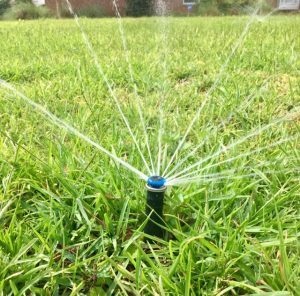When watering to establish a new lawn or when renovating areas within an older lawn, 2-3 “mists” throughout the day for the first 7-10 days until roots get established is recommended. These are 10-minute bursts. Then back off to once a day for about ½ hour for 7-10 days. Then go to 2-3 times a week for about 7 days. By then your lawn should be established.
Irrigation is not needed when we are getting adequate rainfall. Rain counts. In the absence of sufficient rain, you’ll need to provide enough water at the correct time to allow your new sod to root, hence the above directions.
A well designed and correctly installed irrigation system with a controller, operated correctly, helps to achieve uniform establishment. It can be difficult or impossible and inconvenient and time consuming to uniformly provide sufficient water to establish a lawn with hose-end sprinklers, especially with a sizeable lawn and during dry weather. Most people are not going to do the necessary job of pulling hoses around on a regular basis to result in a well-established lawn.
Too much water will result in rot, diseased roots and failure. Too little water will result in the sod, seedlings, sprigs or plugs drying excessively and failure to establish. The end result, will be a poorly established, sparse lawn with weeds, or complete failure.
There is no substitute or remedy for incorrect irrigation when establishing a new lawn or when renovating an older lawn.
It is risky to invest the required time and money if the new lawn cannot be irrigated correctly. Taking the gamble that adequate (not too much, not too little) rainfall will occur when needed to result in a beautiful, healthy, lush lawn is exactly that, a gamble.
An irrigation system is a good tool to supplement rainfall. As much as possible, learn to operate the irrigation controller using the “Manual” setting. It also is wise and is State law to have a rain shutoff device installed and operating correctly. The rain shutoff device overrides the controller when it is raining or when sufficient rainfall has occurred. A rain shutoff device is inexpensive and easily installed. Also, a rain gauge can be an inexpensive tool to help monitor how much rain you’ve received. Rain counts.
The above schedule should help when planting a lawn from seed, sprigs, plugs or sod.
Once the lawn is rooted, your goal change from establishing a root system to developing a deep, strong rooted lawn. To do this, irrigate to provide ½ to ¾ inch of water on an as needed basis. Here are links to a UF/IFAS video and publication with more info on how to do this: https://www.youtube.com/watch?v=W_wn-hwLNtg, https://edis.ifas.ufl.edu/publication/LH025.
- Evaluate and Renovate Landscape During Fall - October 30, 2025
- Summer is Too Hot for Lawn Herbicides - August 23, 2025
- Nuisance Gnats abound in Northwest Florida this spring - June 26, 2025

